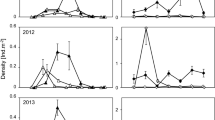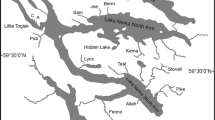Summary
The population densities of sympatric Atlantic salmon,Salmo salar and brook charr,Salvelinus fontinalis, were measured in riffle and pool stream habitats to test whether non-linear isodars, a multispecific model of habitat selection based on ideal distribution assumptions, could (1) predict the distribution of densities between habitats and (2) reproduce the processes postulated to underlie spatial segregation and species interactions in previous laboratory and field studies. The model provided a good fit to observed density patterns and indicated that habitat suitability declined non-linearly with increased heterospecific competitor densities. Competitive effects in riffles appeared to be due to exploitative resource use, with salmon always emerging as the superior competitor. No evidence was found for interference competition in riffles. In contrast, interspecific competition in pools seemed to occur through exploitation and interference. The specific identity of the superior competitor in pools depended on the density of both species; pools provided the charr with refuge from competition with the salmon, presumably through the adoption by the charr of density-dependent behaviours, such as schooling and group foraging, that mitigated the negative impact of the salmon. Charr were displaced from the riffles toward the pools as the total salmon density increased. The isodar analysis, based on limited density data, successfully reproduced the processes suggested to underlie spatial segregation in previous field and laboratory studies and provided new insights into how changes in competitor densities modify habitat suitability in this system.
Similar content being viewed by others
References
Abramsky, Z., Rosenzweig, M.L., Pinshow, B., Brown, J.S., Kotler, B. and Mitchell, W.A. (1990) Habitat selection: an experimental field test with two gerbil species.Ecology 71, 2358–69.
Bohlin, T., Hamrin, S., Heggbert, T.G., Rasmussen, G. and Saltveit, S.J. (1989) Electrofishing—theory and practice with special emphasis on salmonids.Hydrobiologia 173, 9–43.
Bowers, M.A. and Dooley, J.L., Jr (1991) Landscape composition and the intensity and outcome of twospecies competition.Oikos 60, 180–6.
Carle, F.L. and Strub, M.R. (1978) A new method for estimating population size from removal data.Biometrics 34, 621–30.
Danielson, B.J. (1991) Communities in a landscape: the influence of habitat heterogeneity on the interactions between species.Am. Nat. 138, 1105–20.
Efron, B. and Tibshirani, R. (1986) Bootstrap methods for standard errors, confidence intervals, and other measures of statistical accuracy.Stat. Sci.,1, 54–77.
Flack, V.F. and Chang, P.C. (1987) Frequency of selecting noise variables in subset regression analysis: a simulation study.Am. Stat. 41, 84–6.
Foster, S.A. (1985) Group foraging by a coral reef fish: a mechanism for gaining access to defended resources.Anim. Behav. 33, 782–92.
Freedman, D.A. (1983) A note on screening regression equations.Am. Stat. 37, 152–5.
Fretwell, S.D. and Lucas, H.L., Jr (1970) On territorial behavior and other factors influencing habitat distribution in birds. I. Theoretical development.Acta Biotheor. 19, 16–36.
Fuller, W.A. (1987)Measurement Error Models. Wiley, New York.
Gibson, R.J. (1973) Interactions of juvenile Atlantic salmon (Salmo salar L.) and brook trout (Salvelinus fontinalis Mitchill). InProceedings of the International Atlantic Salmon Symposium 1972 (M.W. Smith and W.M. Carter, eds), pp. 181–202. International Atlantic Salmon Foundation.
Gibson, R.J. (1981) Behavioral interactions between coho salmon (Oncorhynchus kisutch), Atlantic salmon (Salmo salar), brook trout (Salvelinus fontinalis) and steelhead trout (Salmo gairdneri), at the juvenile fluviatile stages.Can. Tech. Rep. Fish. Aquat. Sci. 1029.
Gibson, R.J. (1993) The Atlantic salmon in fresh water: spawning, rearing and production.Rev. Fish Biol. Fish. 3, 39–73.
Grant, J.W.A. and Noakes, D.L.G. (1988) Aggressiveness and foraging mode of young-of-the-year brook charr,Salvelinus fontinalis (Pisces, Salmonidae).Behav. Ecol. Sociobiol. 22, 435–45.
Hearn, W.E. (1987) Interspecific competition and habitat segregation among stream-dwelling trout and salmon: a review.Fisheries 12, 24–31.
Kacelnik, A., Krebs, J.R. and Bernstein, C. (1992) The ideal free distribution and predator—prey populations.Trends Ecol. Evol. 7, 50–5.
Kalleberg, H. (1958) Observations in a stream tank of territoriality and competition in juvenile salmon and trout (Salmo salar L. andS. trutta L.).Rep. Inst. Freshwater Res. Drottningholm 39, 55–98.
Lacroix, G.L. (1989) Production of juvenile Atlantic salmon (Salmo salar) in two acidic rivers of Nova Scotia.Can. J. Fish. Aquat. Sci. 46, 2003–18.
Lawlor, L.R. and Maynard Smith, J. (1976) The coevolution and stability of competing species.Am. Nat. 110, 79–99.
McArdle, B.H. (1988) The structural relationship: regression in biology.Can. J. Zool. 66, 2329–39.
McNicol, R.E. and Noakes, D.L.G. (1984) Environmental influences on territoriality of juvenile brook charr,Salvelinus fontinalis, in a stream environment.Environ. Biol. Fish. 10, 29–42.
McNicol, R.E., Scherer, E. and Murkin, E.J. (1985) Quantitative field investigations of feeding and territorial behaviour of young-of-the-year brook charr,Salvelinus fontinalis.Environ. Biol. Fish. 12, 219–29.
Milinski, M. and Parker, G.A. (1991) Competition for resources. InBehavioral ecology (J.R. Krebs and N.B. Davies, eds), pp. 137–68. Blackwell, London.
Montgomery, D.C. and Peck, E.A. (1982)Introduction to Linear Regression Analysis. Wiley, New York.
Morris, D.W. (1987) Tests of density-dependent habitat selection in a patchy environment.Ecol. Monogr. 57, 269–81.
Morris, D.W. (1988) Habitat-dependent population regulation and community structure.Evol. Ecol. 2, 253–69.
Morris, D.W. (1989a) Habitat-dependent estimates of competitive interaction.Oikos 55, 111–20.
Morris, D.W. (1989b) Density-dependent habitat selection: testing the theory with fitness data.Evol. Ecol. 3, 80–94.
Morris, D.W. (1990) Temporal variation, habitat selection and community structure.Oikos 59, 303–12.
Morris, D.W. (1992) Scales and costs of habitat selection in heterogeneous landscapes.Evol. Ecol. 6, 412–32.
Pimm, S.L., Rosenzweig, M.L. and Mitchell, W. (1985) Competition and food selection: field tests of a theory.Ecology 66, 798–807.
Power, G. (1980) The brook charr,Salvelinus fontinalis. InCharrs (E.K. Balon, ed.), pp. 141–204, W. Junk, The Hague, The Netherlands.
Pulliam, H.R. and Danielson, B.J. (1991) Sources, sinks and habitat selection: a landscape perspective on population dynamics.Am. Nat. 137, S50-S66.
Randall, R.G. (1982) Emergence, population densities and growth of salmon and trout fry in two New Brunswick streams.Can. J. Zool. 60, 2239–44.
Rosenzweig, M.L. (1979) Optimal habitat selection in two species competitive systems.Fortschr. Zool. 25, 283–93.
Rosenzweig, M.L. (1981) A theory of habitat selection.Ecology 62, 327–35.
Rosenzweig, M.L. (1986) Hummingbird isolegs in an experimental system.Behav. Biol. Sociobiol. 19, 313–22.
Rosenzweig, M.L. (1991) Habitat selection and population interactions: the search for mechanism.Am. Nat. 137, S5-S28.
Rosenzweig, M.L. and Abramsky, Z. (1985) Detecting density-dependent habitat selection.Am. Nat. 126, 405–17.
Rosenzweig, M.L. and Abramsky, Z. (1986) Centrifugal community organization.Oikos 46, 339–48.
Saunders, R.L. and Gee, J.H. (1964) Movements of young Atlantic salmon in a small stream.J. Fish. Res. Bd. Can. 21, 27–36.
Sutherland, W.J. (1983) Aggregation and the ‘ideal free’ distribution.J. Anim. Ecol. 52, 821–8.
Sutherland, W.J. and Parker, G.A. (1992) The relationship between continuous input and interference models of ideal free distributions with unequal competitors.Anim. Behav. 44, 345–55.
Wankowski, J.W.J. and Thorpe, J.E. (1979) Spatial distribution and feeding in Atlantic salmon,Salmo salar L. juveniles.J. Fish. Biol. 14, 239–47.
Zhang, P. (1992) Inference after variable selection in linear regression models.Biometrika 79, 741–6.
Author information
Authors and Affiliations
Rights and permissions
About this article
Cite this article
Rodríguez, M.A. Habitat-specific estimates of competition in stream salmonids: A field test of the isodar model of habitat selection. Evol Ecol 9, 169–184 (1995). https://doi.org/10.1007/BF01237755
Issue Date:
DOI: https://doi.org/10.1007/BF01237755




